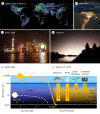Light pollution of freshwater ecosystems: principles, ecological impacts and remedies
- PMID: 37899012
- PMCID: PMC10613548
- DOI: 10.1098/rstb.2022.0360
Light pollution of freshwater ecosystems: principles, ecological impacts and remedies
Abstract
Light pollution caused by artificial light at night (ALAN) is increasingly recognized as a major driver of global environmental change. Since emissions are rapidly growing in an urbanizing world and half of the human population lives close to a freshwater shoreline, rivers and lakes are ever more exposed to light pollution worldwide. However, although light conditions are critical to aquatic species, and freshwaters are biodiversity hotspots and vital to human well-being, only a small fraction of studies conducted on ALAN focus on these ecosystems. The effects of light pollution on freshwaters are broad and concern all levels of biodiversity. Experiments have demonstrated diverse behavioural and physiological responses of species, even at low light levels. Prominent examples are skyglow effects on diel vertical migration of zooplankton and the suppression of melatonin production in fish. However, responses vary widely among taxa, suggesting consequences for species distribution patterns, potential to create novel communities across ecosystem boundaries, and cascading effects on ecosystem functioning. Understanding, predicting and alleviating the ecological impacts of light pollution on freshwaters requires a solid consideration of the physical properties of light propagating in water and a multitude of biological responses. This knowledge is urgently needed to develop innovative lighting concepts, mitigation strategies and specifically targeted measures. This article is part of the theme issue 'Light pollution in complex ecological systems'.
Keywords: aquatic community dynamics; circadian rhythms; conservation; ecosystem functioning; land–water interactions; light physics.
Conflict of interest statement
We declare we have no competing interests.
Figures




References
-
- Hölker F, et al. 2010. The dark side of light: a transdisciplinary research agenda for light pollution policy. Ecol. Soc. 15, 13. (10.5751/ES-03685-150413) - DOI
-
- Sánchez de Miguel A, Bennie J, Rosenfeld E, Dzurjak S, Gaston KJ. 2021. First estimation of global trends in nocturnal power emissions reveals acceleration of light pollution. Remote Sens. 13, 3311. (10.3390/rs13163311) - DOI
Publication types
MeSH terms
LinkOut - more resources
Full Text Sources

